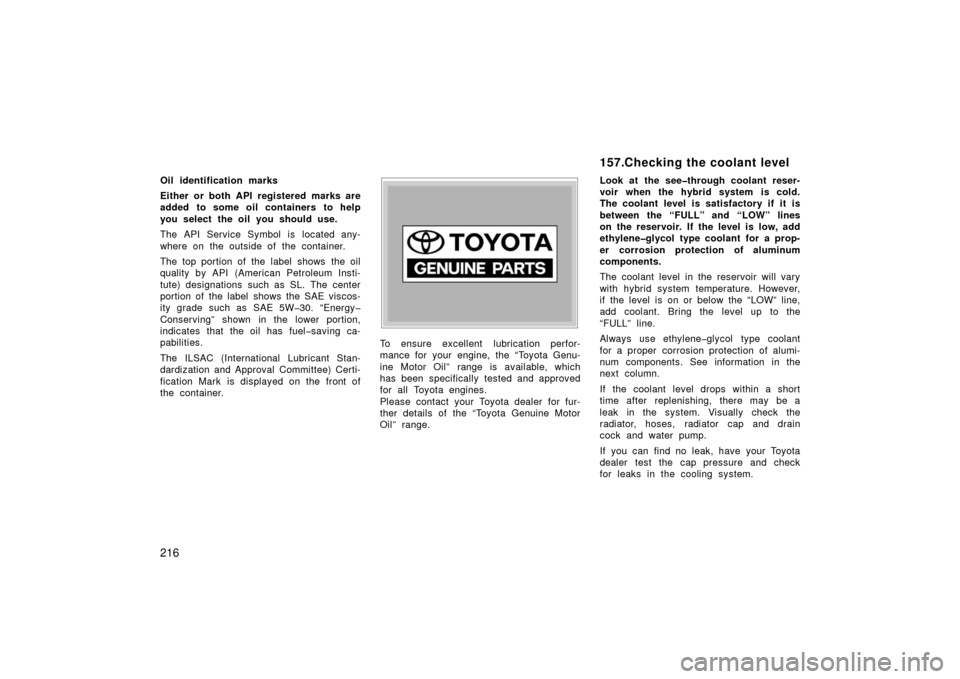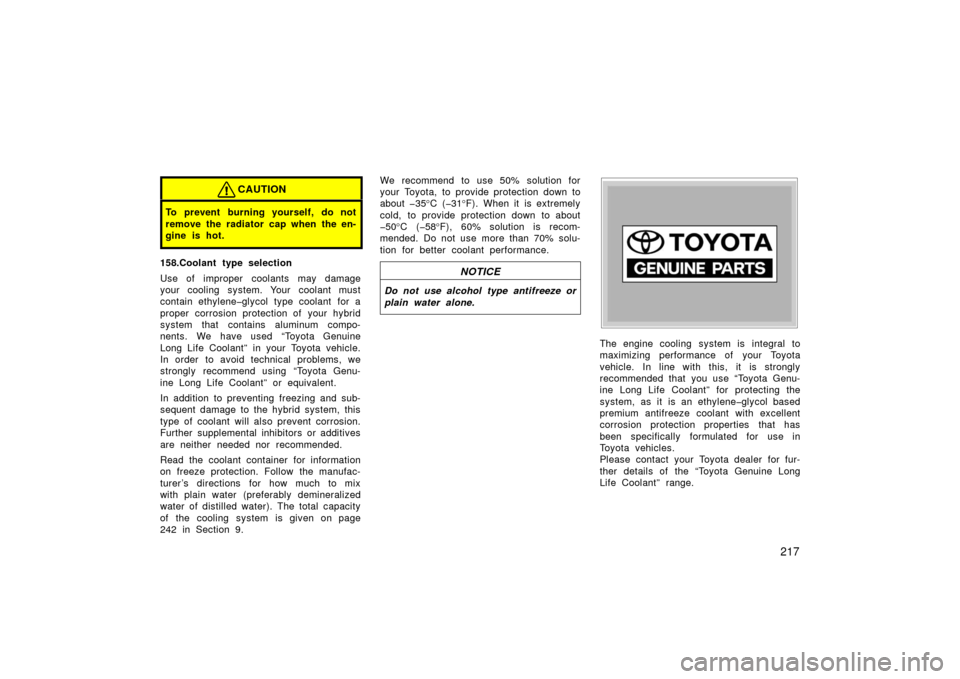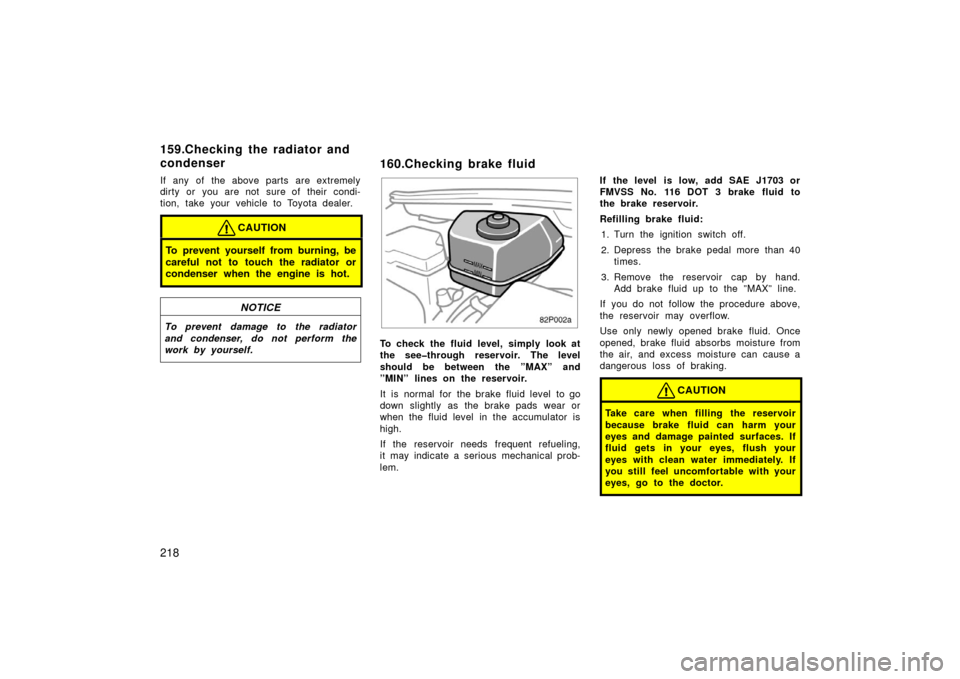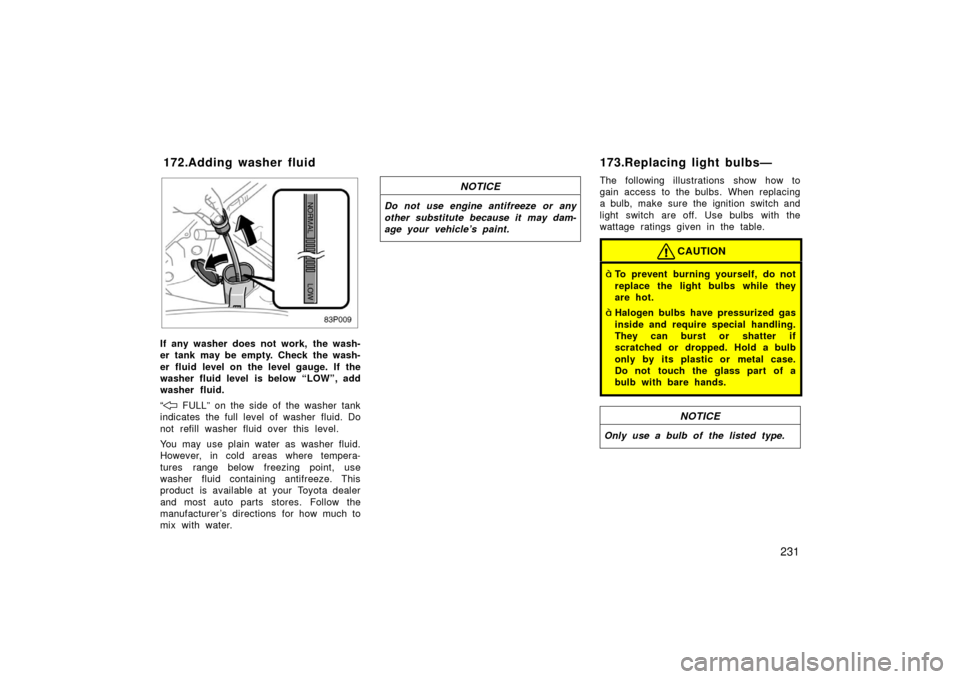Page 222 of 256

216
Oil identification marks
Either or both API registered marks are
added to some oil containers to help
you select the oil you should use.
The API Service Symbol is located any-
where on the outside of the container.
The top portion of the label shows the oil
quality by API (American Petroleum Insti-
tute) designations such as SL. The center
portion of the label shows the SAE viscos-
ity grade such as SAE 5W�30. “Energy�
Conserving” shown in the lower portion,
indicates that the oil has fuel�saving ca-
pabilities.
The ILSAC (International Lubricant Stan-
dardization and Approval Committee) Certi-
fication Mark is displayed on the front of
the container.
To ensure excellent lubrication perfor-
mance for your engine, the “Toyota Genu-
ine Motor Oil” range is available, which
has been specifically tested and approved
for all Toyota engines.
Please contact your Toyota dealer for fur-
ther details of the “Toyota Genuine Motor
Oil” range.Look at the see�through coolant reser-
voir when the hybrid system is cold.
The coolant level is satisfactory if it is
between the “FULL” and “LOW” lines
on the reservoir. If the level is low, add
ethylene�glycol type coolant for a prop-
er corrosion protection of aluminum
components.
The coolant level in the reservoir will vary
with hybrid system temperature. However,
if the level is on or below the “LOW” line,
add coolant. Bring the level up to the
“FULL” line.
Always use ethylene�glycol type coolant
for a proper corrosion protection of alumi-
num components. See information in the
next column.
If the coolant level drops within a short
time after replenishing, there may be a
leak in the system. Visually check the
radiator, hoses, radiator cap and drain
cock and water pump.
If you can find no leak, have your Toyota
dealer test the cap pressure and check
for leaks in the cooling system.
157.Checking the coolant level
Page 223 of 256

217
CAUTION
To prevent burning yourself, do not
remove the radiator cap when the en-
gine is hot.
158.Coolant type selection
Use of improper coolants may damage
your cooling system. Your coolant must
contain ethylene�glycol type coolant for a
proper corrosion protection of your hybrid
system that contains aluminum compo-
nents. We have used “Toyota Genuine
Long Life Coolant” in your Toyota vehicle.
In order to avoid technical problems, we
strongly recommend using “Toyota Genu-
ine Long Life Coolant” or equivalent.
In addition to preventing freezing and sub-
sequent damage to the hybrid system, this
type of coolant will also prevent corrosion.
Further supplemental inhibitors or additives
are neither needed nor recommended.
Read the coolant container for information
on freeze protection. Follow the manufac-
turer’s directions for how much to mix
with plain water (preferably demineralized
water of distilled water). The total capacity
of the cooling system is given on page
242 in Section 9. We recommend to use 50% solution for
your Toyota, to provide protection down to
about �35
°C (�31 °F). When it is extremely
cold, to provide protection down to about
�50° C (�58 °F), 60% solution is recom-
mended. Do not use more than 70% solu-
tion for better coolant performance.NOTICE
Do not use alcohol type antifreeze or
plain water alone.
The engine cooling system is integral to
maximizing performance of your Toyota
vehicle. In line with this, it is strongly
recommended that you use “Toyota Genu-
ine Long Life Coolant” for protecting the
system, as it is an ethylene�glycol based
premium antifreeze coolant with excellent
corrosion protection properties that has
been specifically formulated for use in
Toyota vehicles.
Please contact your Toyota dealer for fur-
ther details of the “Toyota Genuine Long
Life Coolant” range.
Page 224 of 256

218
If any of the above parts are extremely
dirty or you are not sure of their condi-
tion, take your vehicle to Toyota dealer.
CAUTION
To prevent yourself from burning, be
careful not to touch the radiator or
condenser when the engine is hot.
NOTICE
To prevent damage to the radiator
and condenser, do not perform the
work by yourself.
160.Checking brake fluid
82p002a
To check the fluid level, simply look at
the see�through reservoir. The level
should be between the ”MAX” and
”MIN” lines on the reservoir.
It is normal for the brake fluid level to go
down slightly as the brake pads wear or
when the fluid level in the accumulator is
high.
If the reservoir needs frequent refueling,
it may indicate a serious mechanical prob-
lem.If the level is low, add SAE J1703 or
FMVSS No. 116 DOT 3 brake fluid to
the brake reservoir.
Refilling brake fluid:
1. Turn the ignition switch off.
2. Depress the brake pedal more than 40 times.
3. Remove the reservoir cap by hand. Add brake fluid up to the ”MAX” line.
If you do not follow the procedure above,
the reservoir may overflow.
Use only newly opened brake fluid. Once
opened, brake fluid absorbs moisture from
the air, and excess moisture can cause a
dangerous loss of braking.
CAUTION
Take care when filling the r eservoir
because brake fluid can harm your
eyes and damage painted surfaces. If
fluid gets in your eyes, flush your
eyes with clean water immediately. If
you still feel uncomfortable with your
eyes, go to the doctor.
159.Checking the radiator and
condenser
Page 237 of 256

231
83p009
If any washer does not work, the wash-
er tank may be empty. Check the wash-
er fluid level on the level gauge. If the
washer fluid level is below “LOW”, add
washer fluid.
“
FULL” on the side of the washer tank
indicates the full level of washer fluid. Do
not refill washer fluid over this level.
You may use plain water as washer fluid.
However, in cold areas where tempera-
tures range below freezing point, use
washer fluid containing antifreeze. This
product is available at your Toyota dealer
and most auto parts stores. Follow the
manufacturer ’s directions for how much to
mix with water.
NOTICE
Do not use engine antifreeze or any
other substitute because it may dam-
age your vehicle’s paint.
The following illustrations show how to
gain access to the bulbs. When replacing
a bulb, make sure the ignition switch and
light switch are off. Use bulbs with the
wattage ratings given in the table.
CAUTION
�To prevent burning yourself, do not
replace the light bulbs while they
are hot.
�Halogen bulbs have pressurized gas
inside and require special handling.
They can burst or shatter if
scratched or dropped. Hold a bulb
only by its plastic or metal case.
Do not touch the glass part of a
bulb with bare hands.
NOTICE
Only use a bulb of the listed type.
172.Adding washer fluid 173.Replacing light bulbs—
Page 245 of 256
239
174.SPECIFICATIONS
Specifications
Dimensions and weight240
. . . . . . . . . . . . . . . . . . . . . . . . . . . . . . . . . . . . .\
.
Electric motor 240
. . . . . . . . . . . . . . . . . . . . . . . . . . . . . . . . . . . . \
. . . . . . . . . .
Enginee 240
. . . . . . . . . . . . . . . . . . . . . . . . . . . . . . . . . . . . \
. . . . . . . . . . . . . . .
Fuel 241
. . . . . . . . . . . . . . . . . . . . . . . . . . . . . . . . . . . . \
. . . . . . . . . . . . . . . . . . .
Hybrid vehicle battery 241
. . . . . . . . . . . . . . . . . . . . . . . . . . . . . . . . . . . . \
. . .
Service specifications 241
. . . . . . . . . . . . . . . . . . . . . . . . . . . . . . . . . . . . \
. . .
Tires 243
. . . . . . . . . . . . . . . . . . . . . . . . . . . . . . . . . . . . \
. . . . . . . . . . . . . . . . . .
Fuses 244
. . . . . . . . . . . . . . . . . . . . . . . . . . . . . . . . . . . . \
. . . . . . . . . . . . . . . . .
SECTION 9
Page 246 of 256
240
Overall length mm (in.) 4305 (169.5)
Overall width mm (in.) 1695 (66.7)
Overall height mm (in.) 1465 (57.6)*
Wheelbase mm (in.) 2550 (100.4)
Front tread mm (in.) 1475 (58.1)
Rear tread mm (in.) 1480 (58.2)
Vehicle capacity weight
(occupants + luggage)kg (lb.) 363 (800)
*: Unladen vehicle
176.Electric motor
Type: Permanent magnet motor (water cooling)
Rated output: 20 kW
Maximum output: 33.0/1040 � 5600 kW/rpm
Maximum torque: 350.0/0 � 400 N·m/rpm Model: 1NZ�FXE
Type: 4�cylinder in line, 4 cycle, gasoline
Bore and stroke, mm (in.):
75.0 x 84.7 (2.95 x 3.33)
Displacement, cm
3 (cu. in.):
1497 (91.4)
175.Dimensions and weight 177.Engine
Page 247 of 256
241
Fuel type:Unleaded gasoline, Octane Rating 87
(Research Octane Number 91) or
higher
Fuel tank capacity, L (gal., lmp. gal.): 45 (11.9, 9.9)
179.Hybrid vehicle battery
Type: Nickel�Metal hydride battery
Voltage: 7.2 V
Capacity: 6.5 Ah (3HR)
Quantity: 38
Overall voltage: 273.6 V
180.Service specifications
ENGINE
Valve clearance (engine cold), mm (in.):Intake 0.17—0.23 (0.007—0.009)
Exhaust 0.27—0.33 (0.011—0.013)
Spark plug type: DENSO SK16R11
NGK IFR5A11
Spark plug gap, mm (in.): 1.1 (0.043)
178.Fuel
Page 248 of 256

242
ENGINE LUBRICATION
Oil capacity (drain and refill), L (qt, lmp.
qt.):
With filter 3.7 (3.9, 3.3)
Without filter 3.4 (3.6, 3.0)
“Toyota Genuine Motor Oil” is f illed in your
Toyota vehicle. Use Toyota approved “Toyota
Genuine Motor Oil” or equivalent to satisfy the
following grade and viscosity.
Oil grade:
API grade SL “Energy�Conserving” or
ILSAC multigrade engine oil. Recommended oil viscosity:
SAE 5W�30
oil008
Temperature range anticipated before next
oil change
Please contact your Toyota dealer for further
details. 181.COOLING SYSTEM
Total capacity, L (qt., Imp. qt.):
For gasoline engine 4.9 (5.2, 4.3)
For electric motor
and inverter and
converter 2.6 (2.7, 2.3)
Coolant type: “Toyota Genuine Long Life Coolant” is
filled in your Toyota vehicle. In order to
avoid technical problems, we strongly
recommend using “Toyota Genuine Long
Life Coolant” or equivalent.
Please contact your Toyota dealer for
further details.
With ethylene�glycol type coolant for a
proper corrosion protection of aluminum
components
Do not use alcohol type antifreeze or plain
water alone.
AUXILIARY BATTERY
Open voltage at 20 �C (68 �F):
12.6 � 12.8 V Fully charged
12.2 � 12.4 V Half charged
11.5 � 11.9 V Discharged
[Voltage that is checked 20 minutes after
the key is removed with all the lights
turned off]
Charging rates: 3.5 A max.